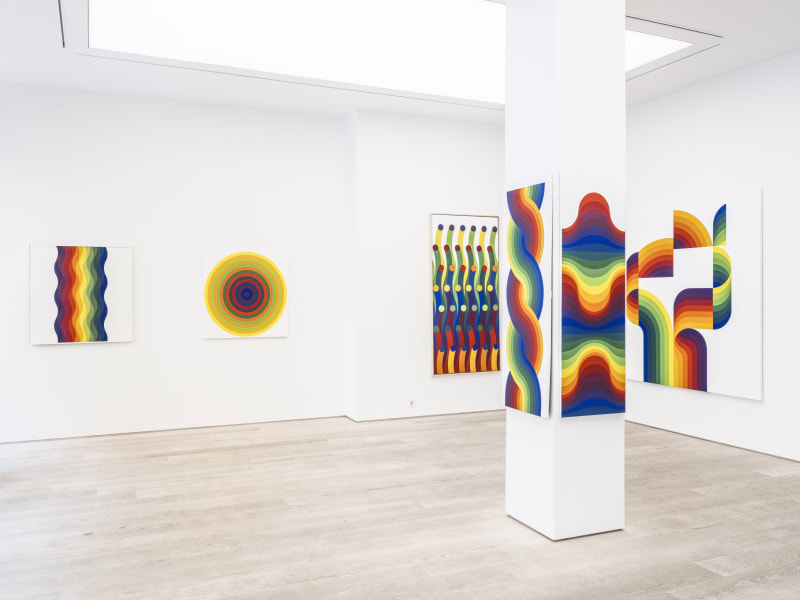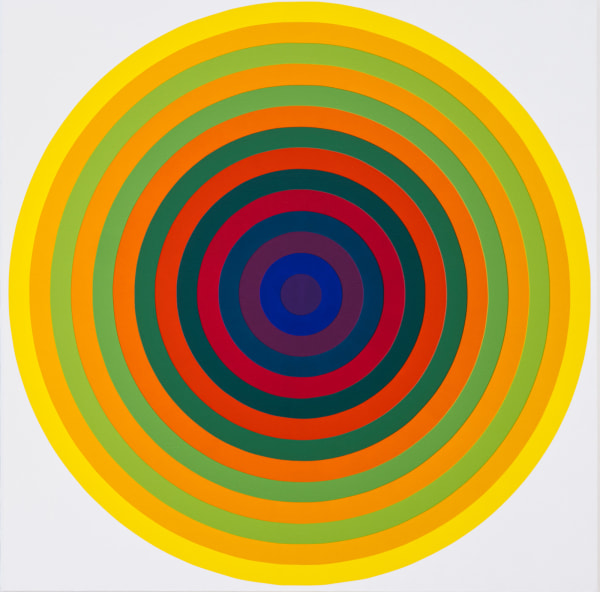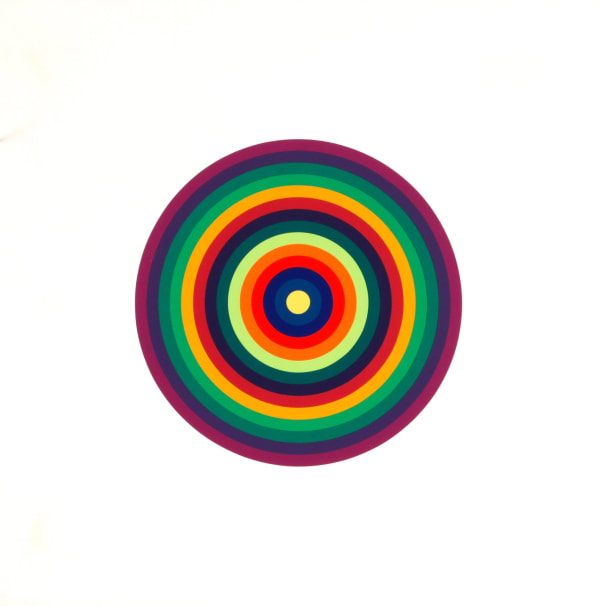Julio Le Parc: Stockholm
Andréhn-Schiptjenko proudly presents an exhibition of thirteen works by Argentinian artist Julio Le Parc from August 18 to October 1, 2022. A pioneer of Op Art and Kinetic Art, this is one of few exhibitions ever held in Scandinavia with Julio Le Parc and includes a selection of vibrant geometric paintings and collage work ranging from the 1970’s to today.
Upon moving to France and there becoming acquainted with other young, like-minded artists such as François Morellet, Horacio Garcia Rossi and Francisco Sobrino, Julio Le Parc co-founded the Groupe de Recherche d'Art Visuel (Visual Art Research Group, 1960–68). This was an artist collective which aimed to make art more accessible and politically relevant, shifting the focus from the solitary artist to the public and moreover, conceiving the public as co-creators of the work. Using industrial, mechanical, and kinetic techniques alike, Le Parc and his peers were sociopolitically invested in generating unmediated encounters between the art object and viewer: staging engaging, dynamic and playful art experiences in the public space of 1960’s Paris.
Central to Julio Le Parc's work has always been the concern for how art might stimulate the active participation of the public. Nothing is to hinder the viewer from experiencing the power of his artworks; no art historical references, symbolism or other kind of previous knowledge necessary. Influenced early on by the constructivist movement known as Arte Concreto Invención, as well as artists such as Piet Mondrian and Victor Vasarely, Le Parc’s quest for accessibility is directly linked to his experimentations on geometric abstraction, optokinetic forms and perception. Experiments whereby he manipulates chromatic color palettes, negative space and the interplay of light and shadow - creating compositions that combine a distinct intensity with a subtle expression of continuous movement.
Though Julio Le Parc’s diverse practice spans painting, sculpture, reliefs, immersive installations, kinetic constructions such as mobiles and even virtual reality works – a similar application of rigorous organizing principles can be found in his works, creating seemingly endless variations and repetitions of colour and form. On his use of colour, Le Parc has said:
“I did some research on colour in 1959. When working with colour, the idea was not at all to do a blue or a “warm” painting, for instance. From the start, I decided to not just use a few colours, but all of them. I wanted them to be pure and not cut with black or white. I did not let myself use any other colours than the fourteen ones I had originally chosen […] All of this research undertaken many years ago now, has been revisited, organized and broadened to give it an increasingly better and more legible form.”
Since the main focus of Le Parc’s work has been consistent throughout his life, it is not of particular relevance to present his artworks chronologically. Bringing together works produced over the last fifty years, the exhibition at Andréhn-Schiptjenko is a visually striking selection of works that engage with one another across time, space and technique.
Julio Le Parc (b. 1928 in Mendoza, Argentina) attended the Academy of Fine Arts in Buenos Aires before moving to Paris in 1958, where he still resides and works. Le Parc represented Argentina at the 1966 Venice Biennale and was there awarded the Grand International Prize for Painting. He has been the subject of two prior solo exhibitions in Sweden: at the Moderna Museet Stockholm in 1969 and at Bildmuseet - Umeå University, Umeå in 2015.
Le Parc is widely exhibited around the world. His latest solo and group exhibitions include Centre d’Art Contemporain de la Matmut, Rouen, France (2021); Maison Hermès, Tokyo (2021); Virtual Contemporary, Istanbul (2021); Tabakalera, San Sebastián, Spain (2020); Musée d'Art Moderne et d'Art Contemporain (MAMAC), Nice (2019); Palais de Tokyo, Paris (2019).
Julio Le Parc is likewise represented in some of the world’s leading modern and contemporary art collections, such as Museo de Arte Moderno de Buenos Aires; Museo de Arte Contemporáneo de Buenos Aires (MACBA); Museu de Arte Moderna do Rio de Janeiro; Musée d’Art Contemporain, Montréal; Louisiana Museum of Modern Art, Humlebaek, Denmark; Museo Nacional Centro de Arte Reina Sofia, Madrid; Albright-Knox Art Gallery, Buffalo, USA; New Orleans Museum of Art, New Orleans; The Museum of Modern Art, New York; Musée d’Art Moderne de la Ville de Paris, Paris; Musée National d’Art Moderne Georges Pompidou, Paris; Museum Boijmans Van Beuningen, Rotterdam, the Netherlands; Tate Gallery, London; Daros Latinamerica, Zurich.
For information and visuals, please contact Hanna Lundberg at hanna@andrehn-schiptjenko.com.
”Jag gjorde en del forskning om färg 1959. När jag arbetar med färg är, till exempel, inte tanken att göra en blå eller en ”varm” målning. Från början bestämde jag mig för att inte bara använda några få färger, utan alla. Jag ville att de skulle vara rena och inte blandade med svart eller vitt. Jag tillät mig inte använda några andra färger än de fjorton jag ursprungligen hade valt […] All denna forskning som genomfördes för många år sedan nu har jag vidareutvecklat, organiserat och breddat för att ge den en allt bättre och mer läsbar form.”
För mer information och bilder, vänligen kontakta Hanna Lundberg på hanna@andrehn-schiptjenko.com.
-

Julio Le Parc
Installation view, Andréhn-Schiptjenko, Stockholm, Sweden, 2022
-

Julio Le Parc
Installation view, Andréhn-Schiptjenko, Stockholm, Sweden, 2022
-

Julio Le Parc
Installation view, Andréhn-Schiptjenko, Stockholm, Sweden, 2022
-

Julio Le Parc
Installation view, Andréhn-Schiptjenko, Stockholm, Sweden, 2022
-
 Julio Le Parc, Ondes 156 no.8, 1972
Julio Le Parc, Ondes 156 no.8, 1972 -
 Julio Le Parc, Série 15 no.8, 1970-2019
Julio Le Parc, Série 15 no.8, 1970-2019 -
 Julio Le Parc, Volume Virtuel 47, 1974
Julio Le Parc, Volume Virtuel 47, 1974 -
 Julio Le Parc, Permutation de la Longue Marche no.1, 2020
Julio Le Parc, Permutation de la Longue Marche no.1, 2020
-
 Julio Le Parc, Ondes 142 no.8, 1974
Julio Le Parc, Ondes 142 no.8, 1974 -
 Julio Le Parc, Volume Virtuel 21, 1974
Julio Le Parc, Volume Virtuel 21, 1974 -
 Julio Le Parc, Volume Virtuel 26, 1974
Julio Le Parc, Volume Virtuel 26, 1974 -
 Julio Le Parc, Ondes 106B no.12, 1972
Julio Le Parc, Ondes 106B no.12, 1972






















